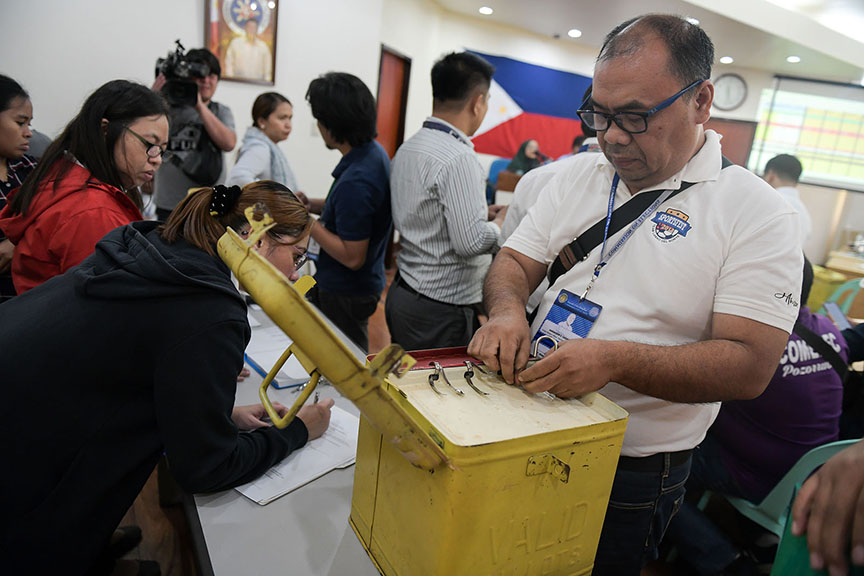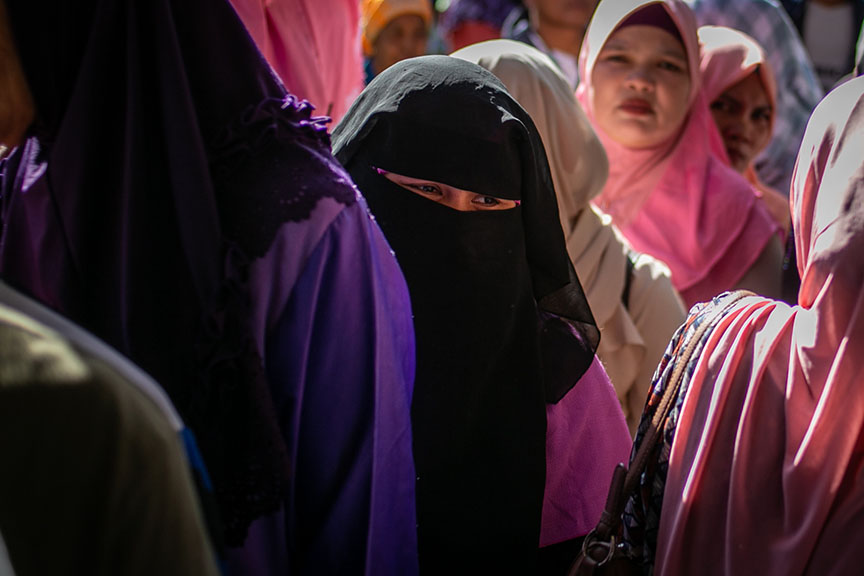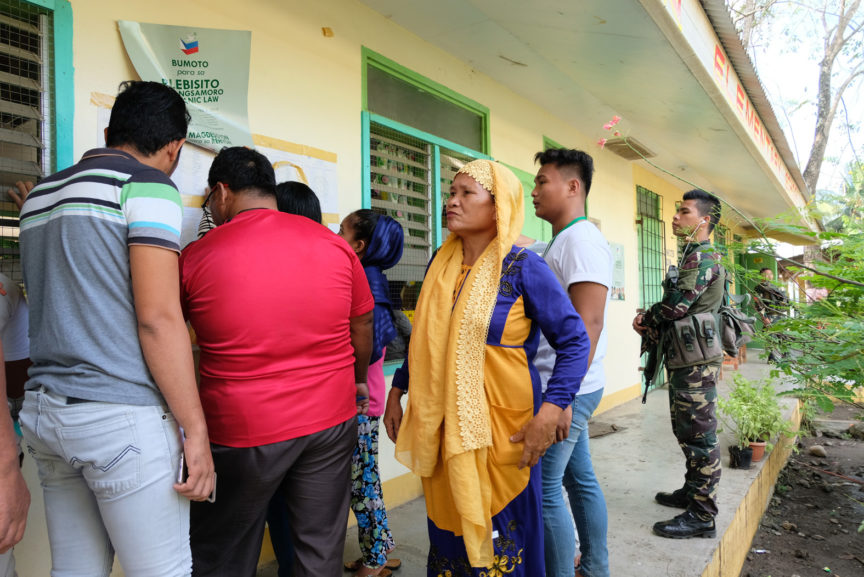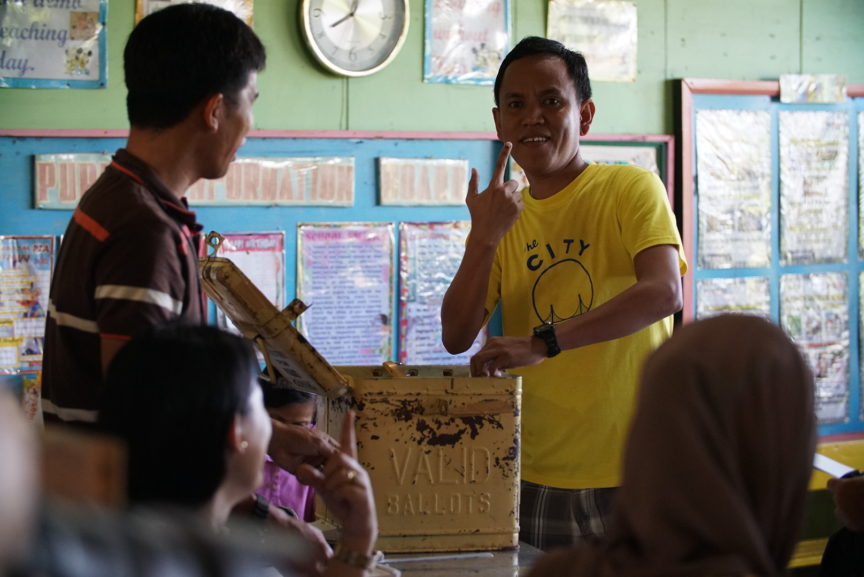Five provinces, three cities, 116 towns, and 63 barangays out of Mindanao’s 27 provinces, 33 cities, 422 towns and 10,084 barangays.
That will be the territorial jurisdiction of the Bangsamoro Autonomous Region in Muslim Mindanao (BARMM): the five-province, two-city, 116-town Autonomous Region in Muslim Mindanao (Maguindanao, Lanao del Sur, Basilan, Sulu, Tawi, tawi and the cities of Marawi and Lamitan), Cotabato City and 63 barangays in six North Cotabato town, results of the January 21 and February 6 plebiscite show.
The Commission on Elections (Comelec) on January 25 proclaimed RA 11054 or the Organic Law for the BARMM ratified by majority vote in the ARMM and Cotabato City during the plebiscite on January 21. The National Plebiscite Board of Canvassers is convening at 2 p.m. Monday for the canvassing of election returns of the February 6 plebiscite in Lanao del Norte and North Cotabato.

A Comelec official checks on the ballot box during the provincial canvassing of the plebiscite on the Bangsamoro organic law in the capital town of Tubod Thursday (7 Feb 2019). MindaNews photo by FROILAN GALLARDO
Al Haj Murad Ebrahim, chair of the Moro Islamic Liberation Front (MILF) and the MILF’s nominee to the post of Bangsamoro Chief Minister, told MindaNews on Monday that “clearly, the landslide ratification of the Bangsamoro organic law and the joining of Cotabato City and the 63 barangays in North Cotabato signify the very clear acceptance as well as high optimism of the people to the Bangsamoro organic law and the BARMM.”
“This also sends a strong message of challenge to the MILF being the lead in the government,” he said.
Cotabato City Mayor Cynthia Guiani-Sayadi had earlier manifested they will file an election protest, citing threats and intimidation by the MILF. She told MindaNews Sunday that they will file the protest this week.
The province of Sulu voted “no” to ratification but will still be part of the BARMM because the law provides that the ARMM votes as “one geographical area,” a provision that Sulu questioned, among others, in its petition before the Supreme Court.
Lanao del Norte, North Cotabato
The six predominantly Muslim towns in Lanao del Norte – Balo-i, Munai, Nunungan, Pantar, Tagoloan and Tangcal – were proposed for inclusion in the BARMM but majority in the 22-town province rejected their inclusion. These six towns voted for inclusion in the supposed expanded ARMM in the August 14, 2001 plebiscite but remained with Lanao del Norte because Congress failed to pass a law constituting it into another province of the ARMM.
RA 11054 or the Organic Law for the BARMM provides for a double majority: even as the six towns vote “yes,” the rest must vote “yes” as well.

Moro women queue for their turn to cast their vote in Barangay Buliok, Pikit, North Cotabato during the Bangsamoro plebiscite on Feb. 6, 2019. MindaNews photo by MANMAN DEJETO
In North Cotabato, 67 villages were proposed for inclusion: 39 had voted for inclusion in the expanded ARMM in 2001 while the petitions for inclusion of the 28 other villages were approved by the Comelec last month.
Sixty-three out of 67 villages in the towns of Aleosan, Carmen, Kabacan, Midsayap, Pigcawayan, Pikit and Tulunan that were proposed for inclusion got the nod of the majority in their respective municipalities.
But Tulunan town voted against inclusion of Barangay Gabilan; Pikit rejected inclusion of Barangay Balatican but voted for the inclusion of 22 others; and Aleosan town voted “no” to the inclusion of two barangays: Pagangan and Lower Mingading. But voted “yes” to inclusion of barangays Dunguan and Tapodoc.
Pagangan’s petition for inclusion was approved last month by the Comelec. Lower Mingading had voted “yes” to inclusion in the ARMM in 2001.
The six Lanao del Norte towns proposed for inclusion are contiguous to Lanao del Sur while the North Cotabato barangays are contiguous to Maguindanao.
From RAG to ARMM to BARMM
The government and Moro National Liberation Front (MNLF) signed on December 23, 1976 the Tripoli Agreement providing for autonomy in 13 provinces and nine cities in Mindanao and Palawan.
These “areas of the autonomy” were to comprise the following: Basilan, Sulu, Tawi-tawi, Zamboanga del Sur, Zamboanga del Norte, North Cotabato, Maguindanao, Sultan Kudarat, Lanao del Norte, Lanao del Sur, Davao Del Sur, South Cotabato and Palawan and “all the cities and villages” therein.
At that time in 1979, there were nine cities situated within the autonomy areas: Zamboanga, Dipolog, Dapitan, Pagadian, Cotabato, Iligan, Marawi, General Santos in Mindanao and Puerto Princesa in Palawan.

Voters look for their names at the Sambulawan Elementary School in Barangay Sambulawan, Midsayap, North Cotabato on February 6, 2019 as a soldier stands guard. MindaNews photo by BONG SARMIENTO
But exercising his martial law powers (he declared martial law in 1972), then President Ferdinand Marcos issued Proclamation 1628 on March 25, 1977 creating two Regional Autonomous Governments (RAGs) instead of just one. He set the plebiscite date on April 17, 1977.
Marcos’ 1628 also created a provisional government covering the 13 provinces, and tasked it to prepare for the conduct of the referendum on the RAGs and election of their legislative assembly and to administer the provinces. The MNLF had negotiated for a provisional government in the Tripoli Agreement of 1976, but not this version of Marcos who named his crony, the warlord Ali Dimaporo, as head. The two RAGs were inaugurated in 1979.
The MNLF protested the Marcos administration’s unilateral decision to declare two regional autonomous governments.
In the 1977 plebiscite, three out of the 13 provinces (South Cotabato, Davao del Sur and Palawan) and two of the nine cities (General Santos and Puerto Princesa) listed under the “areas of the autonomy” of the 1976 Tripoli peace pact rejected inclusion in the RAGs.
Twelve years later, in 1989, yet another plebiscite over the same “areas of the autonomy” was held, this time to ratify RA 6734 or the Organic Act creating the Autonomous Region in Muslim Mindanao (ARMM). The basis for the plebiscite was the provision in the 1987 Constitution creating the ARMM.

A voter shows the indelible ink on his finger inside the Kauswagan Central Elementary School in Kauswagan, Lanao del Norte during the plebiscite on the Bangsamoro Law on Wednesday, February 6, 2019. The law proposes the inclusion of six Lanao del Norte towns to the autonomous region. MindaNews photo by BOBBY TIMONERA
The MNLF in the late 1970s had split into three: MNLF under Nur Misuari, MNLF Reformist Group under Dimas Pundato and MILF under Salamat Hashim. Pundato joined the government when Marcos was toppled by the People Power revolt but the MNLF and MILF boycotted the ratification of the 1987 Constitution and subsequently the 1989 plebiscite on the ARMM. The two fronts pushed for the implementation of the 1976 agreement “in letter and spirit.”
Only four provinces – Sulu, Tawi-tawi, Lanao del Sur and Maguindanao and none of the nine cities voted for inclusion in the ARMM.
Another 12 years later, in 2001, only the Islamic City of Marawi and the province of Basilan, except Isabela City, voted yes to inclusion in a supposed “expanded” ARMM. The plebiscite was to ratify RA 9054, the law that was supposed to have incorporated the provisions of the 1996 “Final Peace Agreement” with the MNLF and allow for expansion of the ARMM.
The MNLF again boycotted the plebiscite, claiming RA 9054 rendered the autonomous region “less autonomous than it was under RA 6734. The MILF by then was still negotiating peace with the government.

A member of the Bangsamoro Islamic Armed Forces, the soon-to-be-decommissioned armed wing of the Moro Islamic Liberation Front waits for his turn to check his name on the voters’ list outside a voting precinct in Kabasalan Elementary School in Barangay Kabasalan, Pikit, North Cotabato, on 06 February 2019. MindaNews photo by CAROLYN O. ARGUILLAS
Since 2001, ARMM had been composed of five Moro-dominated provinces: Lanao del Sur, Maguindanao, Basilan, Sulu and Tawi-tawi and the city of Marawi. Lamitan in Basilan became the second city in the ARMM when it was converted into a city in 2007.
In the 2019 plebiscite, the areas that would form the BARMM are the five-province, two-city, 116-town ARMM plus Cotabato City and 63 villages in six North Cotabato towns.
https://www.mindanews.com/peace-process/2019/02/bangsamoro-is-armm-cotabato-city-63-villages-in-north-cotabato1/

No comments:
Post a Comment
Note: Only a member of this blog may post a comment.